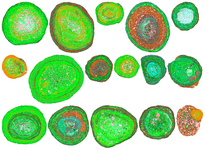Pisolite



A pisolite is a sedimentary rock made of pisoids, which are concretionary grains – typically of calcium carbonate which resemble ooids, but are more than 2 mm in diameter.[1] These grains are approximately spherical and have concentric layers reaching 10 mm in diameter.
The name derives from the Hellenic word for pea. Bauxites, limonites and siderites often have a pisolitic structure.
References
Further reading
- Manutchehr-Danai, Mohsen (2009). Dictionary of gems and gemology (3rd ed.). Springer. ISBN 978-3-540-72795-8.
